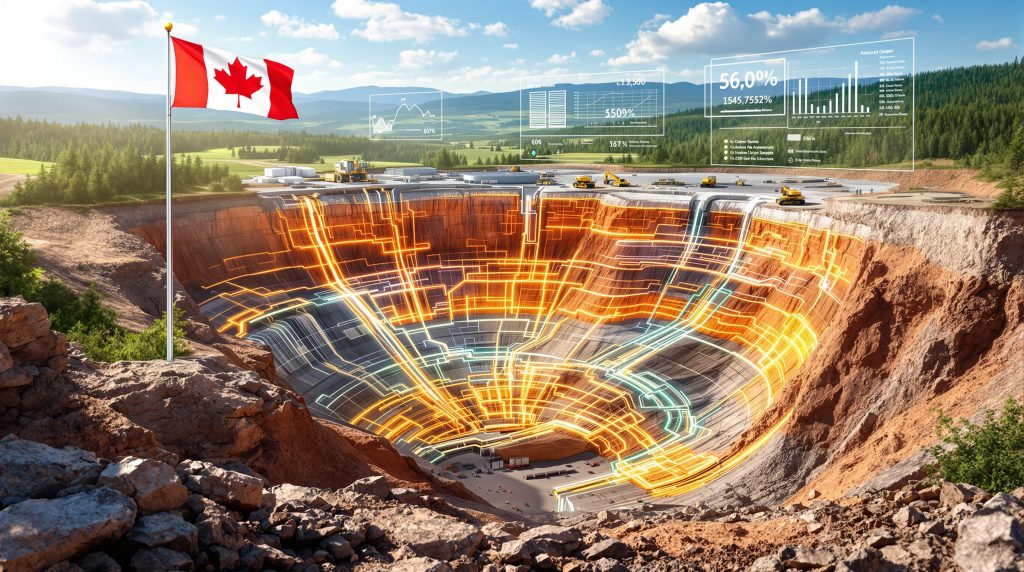Understanding Market Dynamics in North American Copper Exploration
The copper exploration landscape continues evolving as mining companies seek deposits capable of meeting growing industrial demand. Recent developments in eastern Canada demonstrate how strategic geological positioning, combined with favorable infrastructure access, creates opportunities for significant resource development. Understanding these dynamics requires examining both technical mineralisation characteristics and broader market positioning factors that influence project valuation.
Modern porphyry-skarn systems represent some of the most economically viable copper deposits globally, offering the scale and grade consistency necessary for large-scale mining operations. These geological formations develop through complex hydrothermal processes, creating extensive mineralised zones that can support decades of production when properly developed.
Advanced Porphyry Copper System Architecture
Porphyry copper deposits form through intricate geological processes spanning millions of years. These systems develop when metal-rich fluids circulate through fractured host rocks surrounding intrusive igneous bodies, creating disseminated and stockwork copper sulfides across extensive areas.
The complexity of these systems becomes apparent when examining their internal structure. Prograde skarn zones feature high-temperature mineral assemblages formed during initial hydrothermal activity, whilst retrograde alteration areas develop through subsequent fluid circulation events that can significantly enhance copper concentrations.
Hybrid Mineralisation Environments
The most economically significant deposits often exhibit multiple mineralisation styles within a single system. At the Gaspé project, five distinct retrograde vein/stockwork events have been documented, each overprinting earlier mineralisation phases. This creates multiple opportunities for grade enhancement across different geological zones.
Key Mineralisation Characteristics:
• Stockwork vein systems providing structural controls for ore distribution
• Bedding-parallel replacement zones following stratigraphic contacts
• Disseminated copper sulfides distributed throughout altered host rocks
• Secondary enrichment zones where weathering concentrates copper minerals
The presence of chalcopyrite as the dominant copper mineral, accompanied by pyrite and minor molybdenite, indicates favourable metallurgical characteristics for conventional processing methods. This mineral assemblage typically responds well to standard flotation circuits, reducing technical risk during development planning.
Comparative Analysis of Recent Drilling Performance
The new copper intercepts at Gaspé project demonstrate grade and length characteristics that position this deposit among North America's most significant undeveloped copper resources. Recent drilling has returned intercepts that substantially exceed regional averages for similar geological settings.
Furthermore, industry analysts have noted that these results align with broader copper market trends indicating strong demand for reliable copper sources. Moreover, Osisko Metals has announced impressive drilling results from their recent exploration program.
Table: Gaspé Intercept Performance Analysis
| Drill Hole | Length (m) | Copper Grade (%) | CuEq Grade (%) | Tonnage Factor |
|---|---|---|---|---|
| 30-1136 | 284.5 | 0.41 | 0.43 | Bulk tonnage |
| 30-1136 (zone) | 138.0 | 1.45 | 1.52 | Enhanced grade |
| 30-1136 (core) | 64.5 | 2.70 | 2.82 | Premium zone |
| 30-1120 | 598.5 | 0.28 | 0.37 | Massive intercept |
The 598.5-meter intercept from hole 30-1120 represents exceptional continuity, demonstrating the deposit's potential for large-scale, long-life mining operations. Such extensive mineralised intervals typically support robust mine planning scenarios with predictable grade control characteristics.
Grade Distribution Patterns
The mineralisation exhibits classic porphyry-style grade distribution, with extensive lower-grade zones hosting higher-grade cores. This configuration optimises mining economics by enabling selective extraction strategies whilst maintaining overall resource tonnage.
Grade Enhancement Zones:
• 64.5-meter core averaging 2.70% copper represents premium mineralisation
• 138-meter interval at 1.45% copper provides transition grade material
• 284.5-meter envelope at 0.41% copper defines bulk tonnage potential
• Consistent copper-to-equivalent ratios indicating minimal penalty elements
Technical Drivers of Resource Expansion Potential
The structural complexity documented at Copper Mountain creates multiple vectors for resource growth. The identification of five retrograde vein/stockwork events suggests the mineralisation system extends significantly beyond current drilling limits.
Additionally, mineral exploration for copper has become increasingly sophisticated, enabling companies to identify complex geological systems more effectively.
Critical Insight: Multiple mineralising events create overlapping zones of enrichment, potentially expanding both lateral and vertical resource continuity beyond current estimates.
Geological Control Mechanisms
Mineralisation Distribution:
• Copper Mountain: Subvertical stockwork-dominated systems
• Lower Copper Mountain: Bedding-parallel, stratigraphy-controlled zones
• Needle Mountain areas: Prograde skarn-dominated mineralisation
• C Zone and E Zone: Molybdenum-enriched skarn development
The dual porphyry-skarn nature creates complementary ore-bearing environments that enhance overall resource potential. Prograde zones typically offer consistent grade distribution, whilst retrograde areas can contain significant high-grade shoots.
Byproduct Revenue Enhancement
Local molybdenum grades reaching 0.5% Mo in specific zones provide substantial byproduct credits that significantly impact project economics. Sequential flotation processing enables separate concentrate production, creating diversified revenue streams whilst reducing commodity price exposure.
Molybdenum Processing Advantages:
• Enhanced overall metal recovery through optimised circuits
• Separate concentrate sales reducing metallurgical penalties
• Risk mitigation through commodity diversification
• Premium pricing for clean molybdenum concentrates
Global Resource Base Positioning Analysis
The Gaspé project's 1.494 billion tonnes of combined resources represents one of the largest undeveloped copper inventories in North America. At grades averaging 0.34-0.38% copper equivalent, this translates to approximately 5.4 million tonnes of contained copper.
Resource Classification Breakdown:
• Indicated Resources: 824 million tonnes
• Inferred Resources: 670 million tonnes
• Total Resource Base: 1.494 billion tonnes
• Average Grade Range: 0.34-0.38% CuEq
Regional Infrastructure Advantages
Eastern Canadian copper projects benefit from established infrastructure networks rarely available to comparable developments globally. The Gaspé peninsula provides:
Transportation Connectivity:
• Proximity to major North American consumption centers
• Established rail and port infrastructure
• Reduced transportation costs versus remote deposits
• Supply chain security for domestic manufacturing
In contrast, US copper production overview shows how geographical advantages can significantly impact project economics.
Regulatory Environment:
• Predictable permitting timelines
• Established mining law framework
• Political stability supporting long-term investment
• ESG advantages through comprehensive environmental oversight
Exploration Methodology and Targeting Excellence
The current 110,000-meter drilling program employs systematic approaches designed to optimise resource definition whilst testing expansion potential. This comprehensive strategy balances infill drilling to upgrade resource confidence with exploratory drilling to assess system limits.
Program Structure:
-
Infill drilling targeting resource confidence upgrades
-
Step-out drilling testing mineralisation continuity
-
Deep exploration assessing vertical extent potential
-
Geotechnical drilling supporting engineering studies
Advanced Targeting Strategies
Successful intercept generation relies on integrated geological interpretation combining multiple data sources. Structural interpretation of vein orientations guides drill placement, whilst alteration mapping identifies hydrothermal intensity zones.
Targeting Integration:
• 3D geological modelling optimising drill hole placement
• Geochemical vectoring toward higher-grade zones
• Structural controls analysis for mineralisation prediction
• Historical data integration maximising drilling efficiency
Development Timeline and Economic Considerations
The project development schedule reflects comprehensive planning required for large-scale copper operations. Key milestones include an updated Mineral Resource Estimate in early 2026 followed by economic studies supporting construction decisions.
Development Milestones:
• Updated MRE: Early 2026
• Preliminary Economic Assessment: First half 2026
• Construction Readiness: Early 2030s
• Estimated Capital Investment: C$1.8 billion
Capital Investment Framework
The estimated C$1.8 billion capital requirement reflects comprehensive infrastructure development including processing facilities, tailings management, and transportation optimisation. This investment scale positions the project among major North American copper developments.
Infrastructure Requirements:
• Large-scale processing facility construction
• Comprehensive tailings management systems
• Power supply infrastructure enhancement
• Transportation network optimisation
Market Dynamics and Strategic Positioning
Current copper market dynamics strongly favour well-positioned deposits capable of meeting growing demand from electrification initiatives. The new copper intercepts at Gaspé project demonstrate technical characteristics aligned with market requirements for reliable, long-term supply.
Consequently, investors are increasingly seeking copper investment strategies that capitalise on these favourable market conditions. Additionally, expert copper price insights suggest continued strength in the commodity markets.
Future Demand Drivers
Electrification Demand:
• Electric vehicle manufacturing requiring extensive copper infrastructure
• Renewable energy systems with high copper intensity requirements
• Grid modernisation projects demanding significant copper volumes
• Energy storage systems incorporating substantial copper components
The strategic location in eastern Canada provides competitive advantages for serving North American markets whilst meeting increasing demand for domestically sourced critical minerals. However, financial analyses of the project indicate strong investment potential given current market conditions.
Risk Assessment and Investment Considerations
Large-scale copper development projects face multiple risk categories requiring careful evaluation. Technical risks include metallurgical complexity, geotechnical challenges, and environmental permitting uncertainties.
Primary Risk Factors:
Technical Risks:
• Metallurgical complexity of mixed sulfide processing
• Geotechnical requirements for large-scale open pit development
• Environmental permitting timeline variables
• Capital cost inflation in mining construction sectors
Market Variables:
• Copper price volatility affecting project economics
• Competition from other major copper development projects
• Regulatory changes potentially impacting development schedules
• Infrastructure development cost escalation potential
Strategic Risk Mitigation
The project's scale and grade characteristics provide natural hedging against certain risk categories. Large resource bases enable flexible mine planning, whilst consistent grades reduce operational variability.
Risk Mitigation Factors:
• Extensive resource base enabling flexible extraction strategies
• Established infrastructure reducing development uncertainty
• Favourable regulatory environment minimising political risk
• Diversified mineral assemblage providing byproduct revenue
The combination of technical excellence, strategic positioning, and comprehensive development planning positions this project among North America's most significant copper development opportunities, with new copper intercepts at Gaspé project continuing to demonstrate the deposit's exceptional potential.
Looking to Capitalise on Major Copper Discoveries?
Discovery Alert's proprietary Discovery IQ model delivers real-time alerts on significant copper discoveries across the ASX, instantly empowering subscribers to identify actionable opportunities ahead of the broader market. Understand why historic copper discoveries can generate substantial returns and begin your 30-day free trial today to secure your market-leading advantage.




